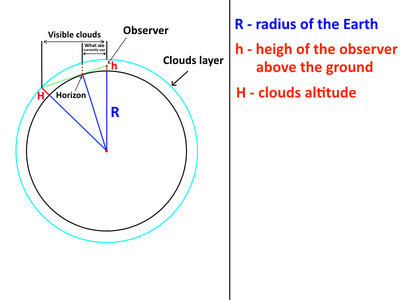- 1,178
- 407
There is a huge problem with clouds measurements using distance to the horizon.
We currently use distance to the horizon to calculate volume of the clunds in cases when the clouds obscure the entire sky. The distance to the horizon is determined by this formula:
S = Sqrt((R+h)^2 - R^2)
Where R is the radius of the planet (6371000m for the Earth) and h is the height of the observer above the ground.
The problem with using distance to the horizon to determine area/volume of the clouds is the fact that are high in the sky which means EVEN IF THE CLOUDS ARE FURTHER THAN THE HORIZON THEY STILL WHOUD BE VISIBLE depending how high they are above the groud. I'll explain it in the image below:

By Pythagorean Theoreme the correct formula to determine the distance to the furthest visible clouds is:
Sqrt((R+h)^2-R)+sqrt((R+H)^2-R)
Where R is the radius of the Planet, h is the height of the observer above the ground and H is the clouds altitude.
Since the area of the visible clouds will always be quite large we should probably always assume spherical cap shape insted of cilinder.
We currently use distance to the horizon to calculate volume of the clunds in cases when the clouds obscure the entire sky. The distance to the horizon is determined by this formula:
S = Sqrt((R+h)^2 - R^2)
Where R is the radius of the planet (6371000m for the Earth) and h is the height of the observer above the ground.
The problem with using distance to the horizon to determine area/volume of the clouds is the fact that are high in the sky which means EVEN IF THE CLOUDS ARE FURTHER THAN THE HORIZON THEY STILL WHOUD BE VISIBLE depending how high they are above the groud. I'll explain it in the image below:

By Pythagorean Theoreme the correct formula to determine the distance to the furthest visible clouds is:
Sqrt((R+h)^2-R)+sqrt((R+H)^2-R)
Where R is the radius of the Planet, h is the height of the observer above the ground and H is the clouds altitude.
Since the area of the visible clouds will always be quite large we should probably always assume spherical cap shape insted of cilinder.
